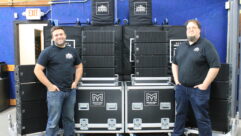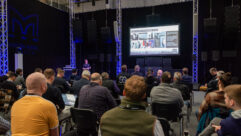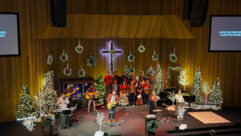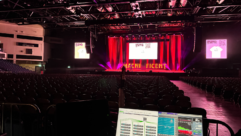High Security: Providing Audio System Supervision for the Lockheed MartinComplex.
Apr 1, 1998 12:00 PM,
R. David Read
During recent years, audio paging systems have been increasingly pressedinto service to provide voice evacuation, sound masking and otherfunctions. These extensions of purpose, beyond the original intent ofproviding paging information to the occupants of a building (or a networkof buildings) have necessitated some unique adaptations. The use of suchsystems in an evacuation mode demands that the system operation beadequately monitored to report any failures. In some cases, this has becomea code requirement.
Since the inception of supervised sound systems, various schemes have beenproposed by several manufacturers to perform this critical monitoringfunction. In many cases, these methods of supervision have required areturn line from the loudspeaker zones or specialized modification of thezone loudspeakers and/or line transformers. These methods, althoughgenerally successful, have traditionally increased the cost of the system’sinstallation components and the necessary labor required to implement thesupervisory aspects of the system. These specialized procedures made itpractically prohibitive to retrofit existing sound systems into anevacuation system.
Unlike conventional class A or B DC 60 mA loop fire-alarm systems, audiosystem supervision requires monitoring a wide dynamic range variablewaveform signal. An audio signal is almost never an AC sine wave.Consequently, the traditional methods of calculating RMS values for AC sinewave power factors are virtually useless in calculating audio signaltransmission.
Even the deceptively named constant voltage (25 V, 70.7 V or 100 V) linesseldom deliver the specified output voltage. In audio systems, theimpedance of the circuit is vastly more important than the simple DCresistance of the transmission lines.
The Lockheed Martin facilityThe Lockheed Martin Federal Systems plant faced just such a problem at itsindustrial complex in Owego, NY. This industrial campus is located some 20minutes west of Binghamton near the Finger Lakes region in the state of NewYork. The facility provides engineering, manufacturing and administrationfor the company’s activities. Lockheed Martin’s industrial complex consistsof a number of buildings located on 800 acres (320 hectares) of land andincludes two heliports, a power house and an onsite waste water treatmentplant. Over the years, the company has installed paging and sound maskingsystems in the 1.5 million ft squared (139,350 meter squared) of officespace within the buildings on this extensive complex.
The site has its own facilities engineering staff to provide service andsupport in the design, construction, installation, operation andmaintenance of its buildings and equipment. This facilities organization isresponsible for managing the various mechanical, architectural,telecommunication, electrical, environmental, security and safety systemsthat are required to keep the plant running smoothly and efficiently-and incompliance with state and federal codes and regulations.
The original buildings at this site were constructed in the late 1950s,with the newest construction dating to the mid-1980s. As was customary forthat era, separate fire alarm and PA systems were installed independentlyof each other and separately for each building. All systems had beeninstalled in conduit for physical protection and in accordance with coderequirements.
Based on an audit of its facility use, Lockheed Martin’s securitydepartment recognized that the voice evacuation aspect of its PA system wasnot supervised in accordance with OSHA Regulation 1910.165 (D) (4), whichcalls for systems that will “provide positive notification to assignedpersonnel whenever a deficiency exists.” To comply with these requirements,it was necessary to find a method of supervising and monitoring the PAsystem and report any faults to the proper personnel. Two avenues could beused to meet these requirements: install new or vastly upgrade existingalready supervised fire alarm systems to incorporate A-V alarms throughoutall spaces using standardized alarm tones, or install new PA systems withthe currently available supervisory system.
The facility was properly equipped with fire alarm systems; however,because of the possibility of hazardous materials spills, EMS or otheremergencies, it was decided to use the installed systems in avoice-evacuation mode and implement system supervision. At the time that itwas decided to expand the use of the sound systems for voice evacuationpurposes and add system supervision, the site already had some 38individual systems, 400 loudspeaker zones and more than 6,000 loudspeakers.A good number of these systems provided both paging and sound masking;others provided basic, primary paging. It seemed like the overall PA systemwas operating correctly, but engineering and maintenance had no way ofensuring that the elements of the systems were working as intended.
Historically, Verrex Corporation, a systems contractor located inMountainside, NJ, had furnished and installed most of the systems at theLockheed Martin complex. The client contacted Verrex and asked for aninvestigation of what was available to provide the necessary supervisoryfunctions. Carol Gowan at Lockheed Martin was designated as the in-housearchitect and engineer to oversee the project.
It was recognized that any solution requiring rewiring all of theloudspeaker zones into a four-wire configuration would be time consumingand costly. Using what appeared to be available supervisory procedureswould also necessitate replacing a good number of sound system componentsin both the PA and sound-masking equipment racks. Berry was aware of someinnovative work in sound system supervision done by Paul Harris at Zytec,Piscataway, NJ. Verrex contacted Zytec and outlined the Lockheed Martinproblem. Harris and his staff turned their attention to finding aneconomical solution.
The system conceptBy using a low-frequency (27 Hz) pilot tone and current-sensing circuitry,a system was developed that did not require return lines or fieldmodification of the loudspeaker/line transformers. The use of asub-audible, highly filtered, supervisory signal provided the accuratemonitoring required, while remaining compatible with paging, backgroundmusic and sound-masking signals. Zytec’s SPV Series One system is composedof an SPV-tx transmitter card and a number of SPV-rx receiver cards (up to15 cards with 30 zones per chassis). By using hub-and-spoke technology,individual systems can be combined to provide the required capacity tosupervise the associated zones. The basic system can monitor up to 30 zonesfrom a single 3.5 inch (89 mm) or 2 RU chassis.
Zytec also developed a smaller, limited zone system. The smaller capacityDominion Series can monitor up to four zones and occupies only half a rackspace. In both cases, the systems were designed to provide mixing on thecard-cage, plug-in modules to eliminate the necessity for additionalexternal mixing and EQ components. Both the SPV Series One and DominionSeries supervisory systems meet the OSHA requirements for existingfacilities that are obligated to comply with these new regulations.
In Zytec’s audio supervisory systems, the pilot signal is injected prior tothe power amps. Consequently, it not only monitors the loudspeaker zonecomponents, but also the power amps’ performance. Based on initial lineimpedance measurements, which are taken and stored at the time ofinstallation, the monitoring system compares the measured values stored onnonvoliate RAM with the real-time condition of the connected zones.
Zytec recognized that the conditions within a given zone had to be comparedon an individual basis, and that an overall averaging of the systemconditions would yield erroneous readings. It was also recognized that asimple act-such as slamming a door-could upset the instantaneouscomparative readings. Hence, a sampling rate was established that wouldnegate the effects of these random instances. By using this technology, thesupervisory system can detect any shorts, opens, grounds or variations inthe number of loudspeakers that constitute the zone load while compensatingfor random variations.
Based on the client’s criteria, the system was developed to provide bothon-board diagnostics, local supervisory status reporting and the ability toreport monitoring status over an RS-232 or RS-422 data link to accompanyingremotely located touchscreen reporting stations. In the event of a failure,it was stipulated that an audible alert be generated, an LED visualindicator be activated and the remote touch-screen displays show thelocation and the nature of the fault. Optional relay closures were requiredfor additional activation of other audible and visual alerting devices.
In addition to providing local notification of faults on any particularsystem, the various systems had to be networked to provide remotemonitoring at the Central Control Center. A BayTech optically isolatedcommunication hub was used to implement this feature in this wide-area,multisystem supervisory network. By using RS-422 transmission, the networkwas able to accommodate data links of 3,000 feet (914 m) length. The systemnetwork was intended to operate over existing telephone grade circuits. Inmost cases, satisfactory operation was realized without the need foradditional repeaters. In this particular system, the normally optionalcontrol system also provided the ability to date-stamp and print the systemstatus.
Testing the conceptLockheed Martin agreed to purchase two Zytec test systems and have theminstalled by Verrex. These two systems would be used to provide supervisionfor 34 zones. For the period of a year, Carol Gowan and her staff carefullyevaluated the operation of the proposed systems and made several additionaloperational and design suggestions. Under strict surveillance from theLockheed Martin staff and by using a number of self-induced failure modeconditions over the year, the test systems were determined to besufficiently accurate to deliver the required supervisory functions. Verrexwas given the green light to implement phase two, which would extend theZytec supervisory system for monitoring an additional 17 racks. Phase threewill complete the installation of supervisory systems throughout theexisting facility.
The installationLockheed Martin is a major defense contractor, and many of the company’sfacilities fall into a high-security category. In many cases, Verrex’sinstallation personnel had to be accompanied to their work locations byLockheed-Martin’s security personnel, who would then remain on hand whilethe work was being performed. The high degree of security required in someareas proved to be an inconvenience to Verrex and Lockheed Martinpersonnel. These conditions slowed down the installation by a considerablemargin.
The preliminary work necessitated a survey of all loudspeakers andequipment. During this survey, it became apparent that the PA system was inless than proper operation. Although paging had been audible in most areas,specific problems were discovered with the loudspeakers, wiring and leveladjustments. Some equipment was replaced, and some wiring errors wererectified. Attenuators were cleaned, amp and processing equipment levelswere optimized, zone paging signals were rebalanced to reflect proper zoneloading, and cable runs were identified and documented.
To minimize conflicts with the facility’s normal work schedule and to avoiddisrupting the noise-masking elements of the various systems, Verrex foundit necessary to work primarily between the hours of 6 p.m. (18:00 hours)and 6 a.m. (0600 hours).
Verrex personnel reported that the system was relatively simple to set up.In the initiating process, it is essential that accurate measurements ofthe system parameters be taken to insure proper operation. However, oncethis data has been attained and stored, the sophisticated comparatorcircuitry of the Zytec system quickly responds to any out-of-tolerancesystem conditions.
The interrelated supervisory systems have proved accurate and have allowedthe Lockheed Martin staff to determine and locate any failures that occuron this widespread paging, sound-masking and voice-evacuation system. Gowanreports that the system is working to the company’s satisfaction, and thatthe client has plans to expand its system and install additionalsupervisory systems. She further stated, “By project completion, it isexpected that overall installation costs incurred will be less than theother methods considered.”









